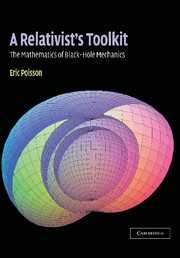1 - Fundamentals
Published online by Cambridge University Press: 02 December 2009
Summary
This first chapter is devoted to a brisk review of the fundamentals of differential geometry. The collection of topics presented here is fairly standard, and most of these topics should have been encountered in a previous introductory course on general relativity. Some, however, may be new, or may be treated here from a different point of view, or with an increased degree of completeness.
We begin in Section 1.1 by providing definitions for tensors on a differentiable manifold. The point of view adopted here, and throughout the text, is entirely unsophisticated: We do without the abstract formulation of differential geometry and define tensors in the old-fashioned way, in terms of how their components transform under a coordinate transformation. While the abstract formulation (in which tensors are defined as multilinear mappings of vectors and dual vectors into real numbers) is decidedly more elegant and beautiful, and should be an integral part of an education in general relativity, the old approach has the advantage of economy, and this motivated its adoption here. Also, the old-fashioned way of defining tensors produces an immediate distinction between tensor fields in spacetime (four-tensors) and tensor fields on a hypersurface (three-tensors); this distinction will be important in later chapters of this book.
Covariant differentiation is reviewed in Section 1.2, Lie differentiation in Section 1.4, and Killing vectors are introduced in Section 1.5. In Section 1.3 we develop the mathematical theory of geodesics. The theory is based on a variational principle and employs an arbitrary parameterization of the curve.
Information
- Type
- Chapter
- Information
- A Relativist's ToolkitThe Mathematics of Black-Hole Mechanics, pp. 1 - 27Publisher: Cambridge University PressPrint publication year: 2004
